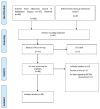The Non-Activated Thromboelastometry (NATEM) Assay's Application among Adults and Neonatal/Pediatric Population: A Systematic Review
- PMID: 35328210
- PMCID: PMC8947108
- DOI: 10.3390/diagnostics12030658
The Non-Activated Thromboelastometry (NATEM) Assay's Application among Adults and Neonatal/Pediatric Population: A Systematic Review
Abstract
The non-activated thromboelastometry (NATEM) assay is a point-of-care assay that can provide a comprehensive insight into the actual hemostatic mechanism. However, there are very limited data about its use in clinical practice. The aim of this study was to systematically review the literature for any data regarding the use of NATEM in several clinical settings. A systematic review of PubMed and Scopus databases was conducted through 20 January 2022 for studies evaluating the use of the NATEM assay in different clinical settings. The literature search yielded a total of 47 publications, 30 of which met the eligibility criteria for this review. Evaluation of NATEM's detecting ability for hemostasis disorders is limited in the literature. The results of the included studies indicate that NATEM seems to be a sensitive method for the detection of hyperfibrinolysis and may have an advantage in the diagnosis of hemostatic disorders. It could be more informative than the other ROTEM assays for detecting changes in coagulation parameters in patients who receive anticoagulants. However, the reported outcomes are highly varying among the included studies. NATEM has a high sensitivity to detect hypo- or hypercoagulability and provides a detailed insight into the whole hemostatic process from clot formation to clot breakdown. It could be a useful technique in variable fields of medicine, not only in adults, but also in pediatric and neonatal populations, to guide different hemostatic treatments and predict coagulation disorders or mortality/morbidity; this issue remains to be further investigated.
Keywords: NATEM; ROTEM; hemostasis; neonates; non-activated thromboelastometry; thromboelastometry.
Conflict of interest statement
The authors declare no conflict of interest.
Figures
References
-
- Bugaev N., Como J.J., Golani G., Freeman J.J., Sawhney J.S., Vatsaas C.J., Yorkgitis B.K., Kreiner L.A., Garcia N.M., Aziz H.A., et al. Thromboelastography and rotational thromboelastometry in bleeding patients with coagulopathy: Practice management guideline from the Eastern Association for the Surgery of Trauma. J. Trauma Acute Care Surg. 2020;89:999–1017. doi: 10.1097/TA.0000000000002944. - DOI - PubMed
-
- Da Luz L.T., Nascimento B., Shankarakutty A.K., Rizoli S., Adhikari N.K. Effect of thromboelastography (TEG®) and rotational thromboelastometry (ROTEM®) on diagnosis of coagulopathy, transfusion guidance and mortality in trauma: Descriptive systematic review. Crit. Care. 2014;18:518. doi: 10.1186/s13054-014-0518-9. - DOI - PMC - PubMed
-
- Görlinger K., Dirkmann D., Hanke A.A. Rotational Thromboelastometry (ROTEM®) In: Gonzalez E., Moore H.B., Moore E.E., editors. Trauma Induced Coagulopathy. Springer International Publishing; Cham, Switzerland: 2016. pp. 267–298. - DOI
-
- Simurda T., Asselta R., Zolkova J., Brunclikova M., Dobrotova M., Kolkova Z., Loderer D., Skornova I., Hudecek J., Lasabova Z., et al. Congenital Afibrinogenemia and Hypofibrinogenemia: Laboratory and Genetic Testing in Rare Bleeding Disorders with Life-Threatening Clinical Manifestations and Challenging Management. Diagnostics. 2021;11:2140. doi: 10.3390/diagnostics11112140. - DOI - PMC - PubMed
Publication types
LinkOut - more resources
Full Text Sources
Miscellaneous


